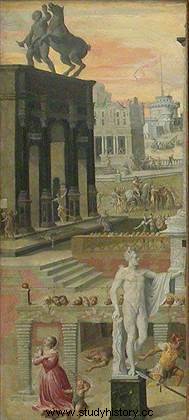 Exhibited at the Louvre, the painting "Massacres of the Triumvirate » refers to the triumvirate composed of Antony, Octave and Lepidus in the year 43 BC. J.-C., after their march on Rome. It is also a parallel with the massacre of Protestants during the religious wars of the 16th century:on April 6, 1561, the Constable of Montmorency, Jacques d'Albon de Saint André and the Duke of Guise formed the Triumvirate - a term given by the party of protestants - for the catholic faith in order to oppose the religious tolerance of Catherine de' Medici
Exhibited at the Louvre, the painting "Massacres of the Triumvirate » refers to the triumvirate composed of Antony, Octave and Lepidus in the year 43 BC. J.-C., after their march on Rome. It is also a parallel with the massacre of Protestants during the religious wars of the 16th century:on April 6, 1561, the Constable of Montmorency, Jacques d'Albon de Saint André and the Duke of Guise formed the Triumvirate - a term given by the party of protestants - for the catholic faith in order to oppose the religious tolerance of Catherine de' Medici
The “Triumvirate Massacres”
This work dated 1566 was made by Antoine Caron in one piece, then divided into three panels, the whole forming approximately one meter fifteen by almost two meters. In 1939, the Marquis de Jaucourt, belonging to an old Protestant family since the Duplessis Mornay, offered it to the Louvre Museum. According to history, this painting is inspired by the wars of religion, but it is very curious to discover ancient and modern monuments of Rome as well as sculptures!
You have to look, analyze, take your time to appreciate this work where symmetry resides everywhere:the columns, the statues, the monuments…even the severed heads! On the right, we discover the Emperor Commodus as Hercules, the Arch of Constantine and the Place du Capitole, the bronze equestrian statue of Marc Aurelius. On the left, the Apollo Belvedere, the Triumphal Arch of Septimius Severus and Trajan's Column. In the background, on the right, the Arc de Triomphe de Titus and on the left, the mausoleum of Emperor Adrian, which has become the Château de Saint Ange (prison) and the bridge. In the center, we can see the levels of bleachers and the circular arcades of the Colosseum. Behind there is the Pantheon and its dome.
These monuments are arranged as if in height and descend towards the viewer, by balustrades and stairs, with a wide place in the foreground. This painting is like a memory of the eternal city, but recalling the historical side and the massacre of the civil wars. The killing scenes are present throughout the painting, especially in the foreground, around the three statues. A reminder of the rise and fall of Rome.
.

The Triumvirate Massacres, Louvre Museum
The painter
Antoine Caron was the official painter of Catherine de Medici, member of the guild of painters of Paris, disciple of Primaticcio whom François 1er had invited to France for the construction of the Château de Fontainebleau .
The work produced refers to the massacres of Saint Bartholomew, although the painting was painted six years before these events...is it a premonition?
This also shows the freedom of artists of the Renaissance period:freedom of expression…because it was necessary to dare to transcribe such a political and religious act due to the regent Catherine de Medici…
